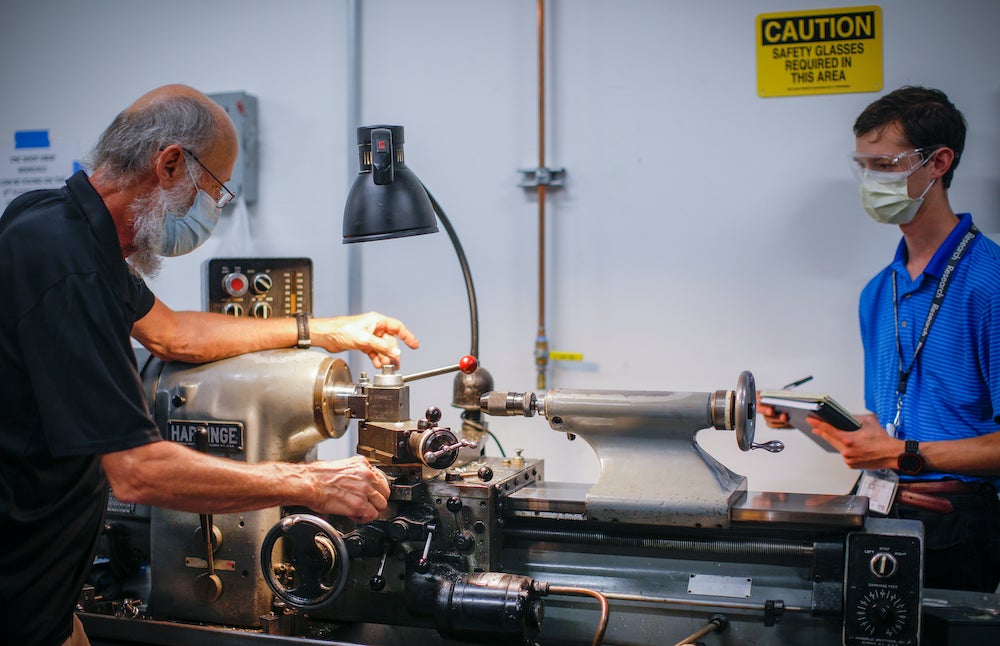On campus, at home, or in between: Learning safely in fall 2020
Introduction
The fall semester at UIC Engineering in 2020 looks very different from the beginnings of prior school years, of course. Behind what you see — fewer students on campus, more masks, more distance — is hard work done all summer long by the engineering and computer science faculty, their teaching assistants, and even students. The six examples below represent just a sliver of the creative ideas, tech-based approaches, safety-oriented thinking, and valuable student feedback that went in to the development of a successful launch for fall 2020.
news story

Bioengineering
UPS, FedEx, and the post office deliver millions of packages a day. This summer, some of those parcels contained the supplies that students needed for Hananeh Esmailbeigi’s BIOE 494 Wearables and Nearables Technology Laboratory. Esmailbeigi, a clinical associate professor of bioengineering, prepared and shipped each student a kit containing 40 components, along with lab manuals and tutorials for all of her course’s projects. Students will use the materials to create actual working devices—starting with fitness bands that track a user’s heart and respiration rates—without leaving their homes.
Chemical engineering
At the heart of chemical engineering are key chemical processes that every student needs to know. At UIC, students usually learn about them in the Unit Operations Laboratory, a specialized teaching facility in the Engineering Innovation Building. To maintain safe distance, students cannot all be in the lab at the same time. So Clinical Associate Professor Alan Zdunek created a special arrangement: one or two students from each four-person lab group come to campus to do the lab, beaming live video to their remaining team members at home. “They relay experimental information in real time during the lab period,” Zdunek said.
Civil, materials, and environmental engineering
No matter when Joseph Schulenberg’s students are ready to learn, the material he prepared is ready for them. Schulenberg based his lesson plans for CME 311 Water Resources Engineering, CME 405 Foundation Design and Analysis, and CME 594 Advanced Foundation Design on an “asynchronous” model, meaning that students can access lecture notes and videos whenever they like, work on projects at home to meet the course’s deadlines, and take quizzes remotely. At the end of each week, Schulenberg sets aside a block of time for each class to chat with the students online and answer their questions.
Computer science
Even before the pandemic, Chris Kanich, associate professor of computer science, used online tools to complement his classroom teaching. Those approaches are now even more valuable. Students make the most of out-of-class time by accessing readings and videos that Kanich posts online; then they meet in small discussion groups on the Blackboard Collaborate platform, where Kanich and his teaching assistants monitor the conversation and provide feedback. The class then switches into a lecture and later breaks into discussion groups once again. The dynamic pace keeps students engaged, and Kanich finds that he receives more questions via chat than he might receive in a typical in-person lecture—which he can answer right then or at the end of class.
Electrical and computer engineering
In a classroom, instructors have multiple sources of information to help them know when their students are confused: the number of questions asked, the proportion of hands raised, the mystified looks on faces in the lecture hall. With those cues either absent or harder to discern in a remote-learning setting, Clinical Assistant Professor Renata Revelo is turning to a new method. Each week, she asks students to identify the “muddiest point in the lecture” and write a short paper that describes what they don’t understand. Knowing which points stymie the majority of her students will help Revelo determine what to address in the following sessions, clearing up matters over time.
Mechanical and industrial engineering
Ever sit in class and drift off for a minute, then wish you could somehow rewind time to go back and listen to what the professor just said? Assistant Professor Sushant Anand’s Introduction to Thermodynamics students had that advantage. Anand taught his classes “live” online on Zoom, but he recorded every class, uploading it to the Blackboard platform afterward. He also gave his students access to a companion platform called Piazza, where students can post questions for Anand or even jump in to answer the questions their peers had posted. Finding out how you did in this class was a snap: Anand used an online module where students could submit each homework assignment and see an evaluation of their performance immediately upon upload.